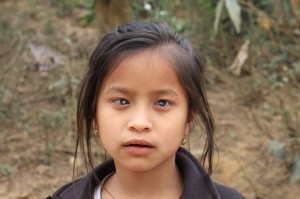Project Phongsali: Yai steps up and is an advocate for villagers!
Day 60
Yai has returned from taking the three visually impaired villagers to the eye clinic in Oudomxai. The return trip presented the same challenges as the outbound journey. Ruts, dust and heat. Roller coaster thrills alternated with hours of boredom. The villagers again became violently carsick.
On one narrow section of road a lumber truck passed without proper clearance, clipped the front of the their bus, and smashed the bus’ windshield. Lune, the young, partially-blind girl in our care, couldn’t see debris flying her way and nearly caught the blast of broken glass in her face.
What should have been a ten-hour trip became an even longer ordeal when the bus was halted several times along the mountain road while work crews cleared landslides. Luckily, this is the dry season and crews can keep the road open with only minimal repair. In another few months, when the monsoon hits, the road may be impassible for days or even weeks at a time.
Yai had both good and bad things to say about the clinic, which is supported by the Fred Hollows Foundation, an Australian NGO (non-government organization). His first hour there saw a rocky start; he was deeply offended by a member of the clinic staff who gave our villagers short shrift and was rudely dismissive of them.
The guy flashed some fingers in front of Mrs. San, the middle-aged woman from Pun Yan village. When she failed to see anything at all he pronounced her case hopeless and immediately turned to Sang, the survivor of cerebral malaria. He flashed the same finger test before him and immediately announced the same diagnosis: “Hopeless. Can’t see a thing.” Ten-year-old Lune’s turn was next. Same finger test. Same conclusion.
Yai suspected that the fellow was eager to be done with our villagers because they had interrupted some on-the-job relaxation. After the perfunctory examination the man cheerfully invited Yai into an office and poured him a glass of beer, from an already open and partially consumed bottle. Away from patients, the fellow was cheerful, friendly and talkative.
Fortunately, Yai stepped up for the villagers. He sought out a nurse and explained to her that, while Mrs. San was indeed blind, both Sang and Lune retained some vision. Yai showed the nurse the simple eye exam that he had constructed for Lune and emphatically explained that the little girl could read letters and numbers if they were written in a large font. He explained that Sang was able to identify colors and large shapes and could, under best lighting, identify common objects held a couple of feet in front of his face.
The nurse made certain that all three of the villagers met another staff member, a Mr. Petsamone. She told Yai that she was confident that Petsamone would spend more time with them and conduct a more thorough exam.
Yai could not have been more pleased with Mr. Petsamone. He was generous with his time, thorough with his exam, and compassionate in articulating his diagnosis. While the first fellow was forceful and blunt, speaking as if the villagers were deaf as well as visually impaired, Mr. Petsamone delivered his judgments respectfully.
Mr. Petsamone told Yai that of our three patients, only Lune has a condition that could, theoretically, be corrected. However, she needs a corneal transplant, a procedure unavailable in Laos for two reasons: lack of tissue donors and prohibitive cost. In America Lune’s vision might be restored. In Laos she has no hope.
The Oudomxai clinic plans two days of outreach activities at the May District Hospital in late April, only 12 kilometers from Sop Houn. Yai will share his experiences at the Oudomxai clinic with the doctors at both Sop Houn and Muang May, and encourage them to identify and alert other eye patients of the upcoming opportunity.

